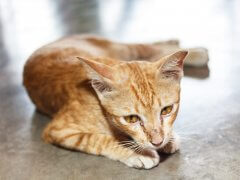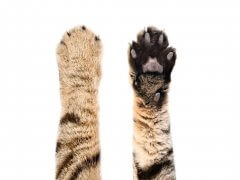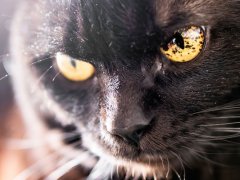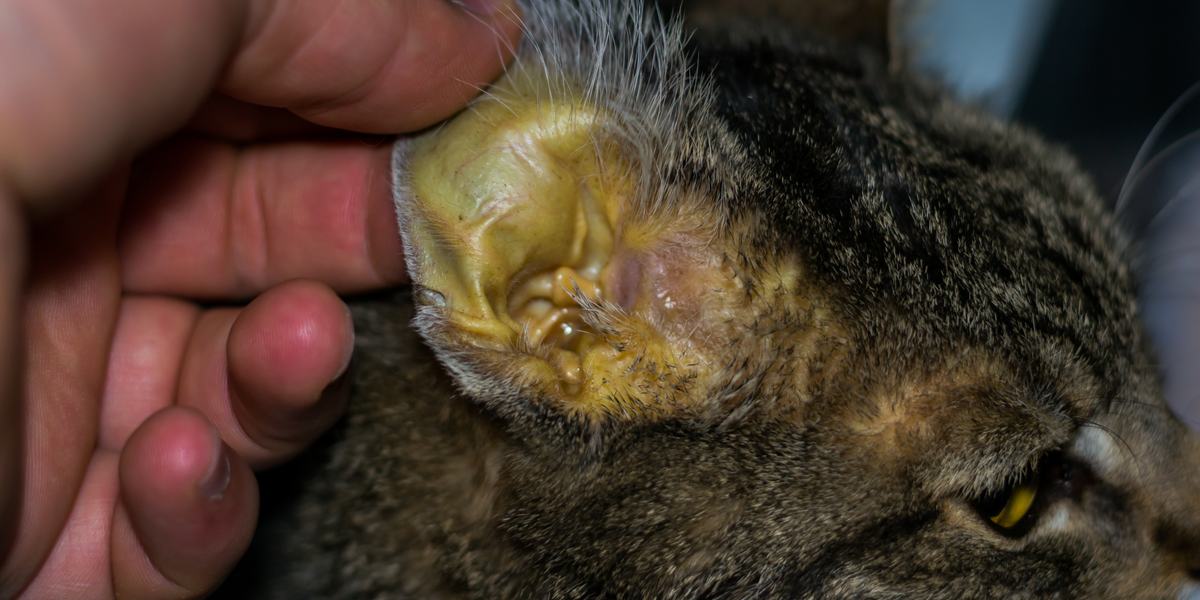
A diagnosis of jaundice (icterus) in your cat can be worrying for cat owners. Read on for clear facts about what this means, and about the possible consequences for pet health.
Quick Overview: Jaundice (Icterus) in Cats





What Is Jaundice?
Jaundice describes the accumulation of higher than normal amounts of a yellow pigment called bilirubin in the bloodstream and body. Jaundice results in visible yellowing of a range of body structures. This can be seen at multiple sites around the body:
- The oral mucous membranes (gums, lips, and tongue), which are normally pink, show discoloration, often turning yellow.
- The eyes appear yellowed because the conjunctival membrane, which is normally pink, and the sclera (white of the eye), which normally white both look yellow.
- The cat’s skin, which is normally white, appears yellow. This is not always easy to see because much of the skin is covered in fur. The yellow color is most easily seen in hairless places such as the inside of the ear pinnae, or the underside of the abdomen.
Why Does Jaundice Develop?
The yellow pigment in the body known as bilirubin is produced when the red blood cells in the bloodstream are broken down. This normally happens to the red blood cells at the end of their natural life (around 120 days), and the resulting bilirubin is normally processed in the liver.
It’s broken down into byproducts that are then normally excreted via the bile into the feces, through the gall bladder, the bile duct, and then into the intestinal contents.
What Causes Jaundice?
The presence of jaundice indicates that an excessive amount of bilirubin has accumulated in the body. There are three main reasons for this:
- An excessive amount of bilirubin is being produced from red blood cell breakdown and the system of metabolizing it has been swamped and cannot cope
- The liver is not functioning properly and so cannot metabolize the normal amounts of bilirubin
- There is an obstruction of the system of excreting the byproducts of bilirubin metabolism into the bile and then into the feces, resulting in an accumulation of bilirubin in the body
Some common medical issues that cause jaundice include:
1. Pre-Hepatic Disease
This means a disease that happens before the liver, and the most common issue is so-called “hemolysis” when there is increased destruction of red blood cells, producing unusually large quantities of bilirubin, which the liver cannot cope with, leading to an higher levels of bilirubin in the body, and hence jaundice.
There are several possible causes of hemolysis, including autoimmune hemolytic anemia, some toxins, and a blood parasitic bacteria called Mycoplasma haemofelis.
2. Hepatic (Liver) Disease
The liver can commonly be adversely affected by a number of different conditions that keep it from functioning normally, preventing the processing of the normal amounts of bilirubin that are produced. Broadly, this is known as liver failure, and this leads to the accumulation of higher levels of bilirubin in the body, and hence jaundice.
There is a long list of possible types of liver disease, with common causes including:
- Acute hepatitis (toxins, drug reactions, viral and bacterial infections)
- Chronic hepatitis (viral and bacterial infections, drug reactions, immune mediated disease)
- Cholangiohepatitis
- Neoplasia (cancer)
- Hepatic lipidosis or fatty liver – the accumulation of fat in the liver, preventing its normal functioning
- Feline Infectious Peritonitis (FIP)
- Cirrhosis (long term changes to the liver with proliferation of scar tissue
3. Post Hepatic Disease
This describes the situation where the normal passage of processed bilirubin (byproducts) from the liver to the feces is prevented by some sort of obstruction between the liver, the gall bladder, the bile duct, and the intestines.
The obstruction means that the body cannot get rid of the pigmented by products, and this blockage in the system leads to the accumulation of higher levels of bilirubin, and hence jaundice. Examples include:
- Bile duct stones
- Cholangitis (inflammation of the bile duct system)
- Cholecystitis (inflammation of the gall bladder and bile duct)
- Bile duct rupture
- Bile duct cancer
- Pancreatitis or pancreatic tumor
What Are the Clinical Signs of Jaundice?
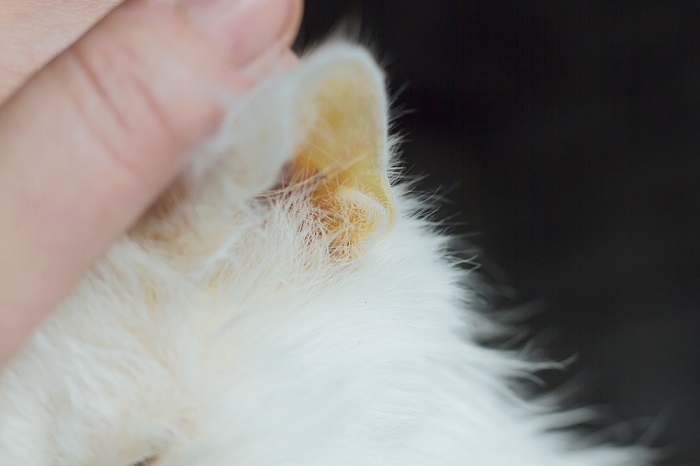
It’s easy to see visibly yellow skin in the later stages of jaundice.
In the early stages, jaundice may be asymptomatic—there may not be visible yellowing, but if a blood sample was examined, the increased pigment in the blood stream would be identified. As the condition progresses, with increased levels of bilirubin in the blood stream, the yellowing becomes visible and obvious.
There are often other signs of illness, not caused by the jaundice, but rather caused by the condition that is causing the jaundice. These include:
- Loss of appetite (not eating as much as normal) or even anorexia (not eating at all)
- Polydipsia (excessive drinking of water)
- Dullness
- Weight loss
- Drooling, excessive salivation
- Gastrointestinal signs such as vomiting and diarrhea
- Swollen abdomen, also known as ascites
- Delays in blood clotting, leading to unexpected bleeding episodes
Diagnosis
The diagnosis of jaundice/icterus is often simple—your cat appears yellow, with yellow ears, yellow skin, yellow eyes, and yellow gums and tongue. In less severe cases, where this yellow pigmentation is not extreme, the diagnosis may be made by your veterinarian after examining a blood sample. The diagnosis of the specific cause of the jaundice is more complex, requiring detailed history taking, physical examination, blood samples, x-rays, ultrasound, and sometimes referral to a specialist.
How Is Jaundice Treated?
Jaundice is a serious issue that requires urgent veterinary attention. Your vet will ask lots of questions about your cat and will want to run certain tests to find out what is causing your cat’s jaundice.
1. Detailed History Taking
Your vet will discuss every aspect of your cat’s condition and review their overall cat health. There are a number of different possible causes of jaundice, and this careful history gathering will help to pinpoint the cause.
Many factors are important in this history. For instance, senior cats are more prone to certain problems than younger cats, and cats that are free-roaming are more prone to some problems than indoor-only cats. A dietary history is also important. What sort of cat food does your cat eat? Has a new food been started recently? Are they being fed any supplements?
Your vet will also ask if your cat is on any medication, if there are any other factors that could be affecting their digestive system, and whether the cat urinating normally (cat owners should always carefully observe their pet’s behavior in the litter box).
2. Physical Examination
As well as noting the extent of the jaundiced appearance, your veterinarian will check your cat’s body carefully all over, feeling the cat all over, checking for any abnormalities. This will normally include taking the cat’s temperature, listening to their chest with a stethoscope and weighing the cat.
3. Routine Blood and Urine Tests
It’s very likely that your veterinarian may carry out blood work, including the usual panel of diagnostic tests, such as hematology (complete blood count or CBC) and biochemistry profiles (including liver enzymes, electrolytes, and bilirubin). Simple urine tests may also be carried out.
This type of work up is known as the minimum database, and it’s carried out to review most sick cats, regardless of the signs of illness. The results will provide helpful guidance toward the type of cause of jaundice.
4. Specialized Blood Tests
Your veterinarian may recommend specific blood tests, such as thyroid hormones (to rule out hyperthyroidism), as well as tests for some viral infections such as feline leukemia virus (FeLV) and feline immunodeficiency virus (FIV), since there are significant implications if your cat is positive for either of these.
Sometimes extra tests known as liver function tests may also be done. These measure the way some chemicals are processed by the liver, getting a clearer picture of how the liver is actually working.
The clotting factors in the blood may be measured, especially prior to extra tests such as liver biopsies, to avoid complications of bleeding during these procedures.
5. Additional Tests
Radiography (x-rays) and abdominal ultrasound examinations may be taken to examine the details of the liver and related structures (such as gall bladder, pancreas, and intestines). Depending on the case, more detailed diagnostic imaging (such as CT or MRI scan) may rarely be recommended. Tests for heartworm may be carried out.
If liver disease is suspected as the cause of the jaundice, to make a precise diagnosis of the type of liver disease, a biopsy of the liver may be recommended, either as a fine needle aspirate (to collect liver cells) or a trucut biopsy (to collect a section of liver tissue). These may be done through the skin under ultrasound guidance (with or without sedation) or a full laparotomy (surgical operation) may be carried out, under general anesthesia.
6. Referral to a Specialist
Your local veterinarian may recommend referral to a veterinary internal medicine specialist, who has a particular interest in investigating and treating jaundice.
Treatment Options for Jaundice in Cats
The treatment of jaundice depends entirely on the underlying cause of the condition: pre-hepatic, hepatic, and post-hepatic jaundice all require a different type of treatment, and even within each of those categories, each different precise cause needs a different approach.
The main goal of your veterinarian is to determine an accurate diagnosis of the cause of the jaundice, and appropriate treatment can then be given. Examples include:
Pre-hepatic jaundice: If autoimmune hemolytic anemia is present, immunosuppressive drugs may be needed, or if a M. Hemofelis is present, specific treatment for this is needed. Blood transfusions are sometimes needed.
Hepatic jaundice: The details of treatment depend on the precise type of liver disease, but general liver supportive care is often given to help the liver continue to play its important role in the body’s metabolism. This includes:
- Admission to the animal hospital for hospitalization and intravenous fluids
- Special diets including highly digestible carbohydrates
- A feeding tube may be used to offer nutrition if a cat has stopped eating
- Nutritional supplements
- Vitamin K may be given, especially if there are issues with blood clotting
- Drugs to ease the signs of illness suffered by the cat (e.g. anti-nausea drugs, and pain-relieving medication)
- Antioxidants
- Bile acid modifying supplements
Post-hepatic jaundice: Treatment depends on the precise type of post hepatic jaundice. For instance, if there is a bile duct obstruction, this may need to be removed, if there is inflammation of the gall bladder, this needs to be treated. Again, the key is the precise diagnosis of the underlying problem.
What Is the Prognosis for Cats With Jaundice?
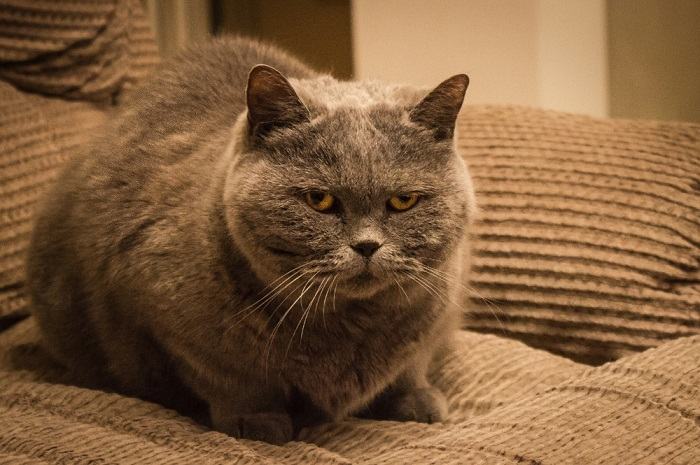
Jaundice is the accumulation of higher than normal amounts of bilirubin in the bloodstream and body.
The prognosis depends on the underlying cause of jaundice. Many of the possible causes have a good prognosis, with appropriate treatment, but others, such as liver cancers, cannot be cured. Cat owners should discuss the individual nature of their cat’s condition with the veterinarian treating their pet, so that individualized advice can be given.
What Is the Life Expectancy of a Cat With Jaundice?
Life expectancy depends on the cause of the jaundice. Some cats can live for many years; others may have a shortened life. Again, a detailed discussion with your own veterinarian is needed to know the expectation for your individual pet.
Clarification: What Is the Difference Between Jaundice and Icterus?
There is no difference between jaundice and icterus—both words have precisely the same meaning. Both are used to describe the yellow pigmentation of the skin, the yellowing of the whites of the eyes, and of the other mucous membranes in the body.
- The word “icterus” is derived from the Greek word “icteric,” which describes the medical condition when a person has yellowing of the skin.
- The word “jaundice” is derived from the French word “jaune,” which means yellow.
For the purposes of this article, the term jaundice will was used, to avoid unnecessary repetition of both words.
In Summary
If you are told that your cat has jaundice, discuss this in detail with your veterinarian so that the condition can be fully investigated, the underlying cause identified, and a detailed treatment plan put in place. The sooner the cause is identified, the better the chances of a positive outcome for your cat.
Also Read: Do Cats Know When You’re Sick?
Frequently Asked Questions
How long can cats live with jaundice?
This depends on the cause of the jaundice. Some cats can live normal life spans; others may only live for weeks or months.
What are the signs of jaundice in cats?
Signs of jaundice are yellowing of various visible parts of the body, including the eyes (and the lining of the eyes), the oral cavity (lips, gums, tongue), and the skin (especially the ears and the underside of the abdomen).
Is jaundice in cats treatable?
Yes, there are many possible treatment options for most types of feline jaundice, but this does depend on diagnosing the precise cause.
Are cats with jaundice in pain?
Jaundice generally is not painful, but this is an individual issue, and for some cats, good quality pain relief can be an important part of therapy. You should discuss this with, and be guided by, your veterinarian.
